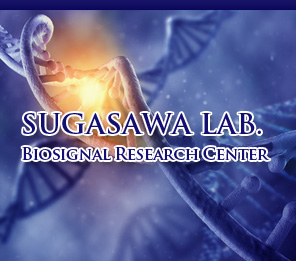Research
For all organisms, of course including our species, it is critical to maintain properly the structural and functional integrity of DNA, as a blueprint for genetic information. However, a fundamental problem is that DNA is highly susceptible to damage caused by its own vulnerability, by endogenously produced agents such as reactive oxygen species, and by numerous environmental factors including radiations and chemicals. DNA damage, if unrepaired, can interfere with various DNA metabolisms such as replication and transcription, thereby inducing mutations, chromosomal aberrations, cellular senescence and/or apoptosis. These adverse effects of DNA damage have recently been implicated in a variety of pathological states in humans.
For instance, when our skin is exposed to sunlight, distinctive DNA damage like cyclobutane pyrimidine dimers (CPDs) and pyrimidine-pyrimidone (6-4) photoproducts (6-4PPs) are produced by ultraviolet light (UV), which in mammals, are fixed exclusively through the nucleotide excision repair (NER) pathway. Notably, hereditary defects in NER are associated with several human autosomal recessive disorders, including xeroderma pigmentosum (XP). Because patients with XP have a problem in removing the UV-induced DNA photolesions, they exhibit not only characteristic photosensitivity, but also a marked predisposition to skin cancer due to the elevated mutation rates. Thus, it is clear that NER functions as our important defense system against carcinogenesis.
In addition to XP, a number of human syndromes are associated with DNA repair deficiency and/or abnormal DNA damage responses, which are often implicated in cancer susceptibility as well as various complicated clinical symptoms, such as growth retardation, neurological degeneration, premature ageing, and so on. Our research goal is to understand the molecular basis underlying DNA repair and cellular DNA damage responses, which protect us from various pathogenic processes, and eventually to control those diseases. Currently we focus on the following research subjects.
1. Molecular mechanisms underlying DNA repair and its regulation
Since our genomic DNA is huge in size, it is critical to understand how cells discriminate a small number of lesions from normal DNA present in vast excess. We showed that, in mammalian NER operating throughout the genome, the XPC protein, one of the XP-related gene products, plays an essential role in DNA damage recognition and initiation of the repair reaction. XPC is capable of recognizing and binding in vitro to various DNA insults, such as UV-induced 6-4PPs and other chemically induced bulky base adducts, which do not share any common chemical structure. We demonstrated that XPC recognizes the presence of oscillating "normal" bases that are prevented from the canonical Watson-Crick base pairing, instead of any features of altered DNA chemistry. This biochemical nature of XPC provides an important molecular basis for the remarkable versatility of the NER pathway.
Among a wide variety of NER substrates, CPDs are exceptional in that these lesions are refractory to detection by XPC because of the very small helix distortion associated. To solve this problem, the UV-damaged DNA-binding protein (UV-DDB), which consists of the DDB1 and DDB2 (XPE) subunits, plays a critical role. We showed that UV-DDB efficiently recognizes the UV-induced photolesions, both CPDs and 6-4PPs, and vitally recruits XPC to the sites of DNA damage. The CUL4 ubiquitin ligase associated with UV-DDB is then activated, thereby poly-ubiquitylating DDB2 and XPC. Once DDB2 is ubiquitylated, UV-DDB loses its DNA-binding activity, whereas the ubiquitylated XPC remains to interact with damaged DNA, suggesting that the damage handover from UV-DDB to XPC is accomplished with the aid of ubiquitylation.
As described above, XPC never senses any chemical alteration in DNA. To avoid adverse DNA incision by NER at damage-free sites, it is critical to verify the presence of damage after DNA binding by XPC. We have recently reported that the transcription factor IIH (TFIIH) is a key factor involved in this step. After XPC binds to a suspicious site that contains unpaired bases, TFIIH is recruited and one of the TFIIH subunits, the XPD helicase, scans a DNA strand in 5' to 3' direction. When the translocation by XPD is blocked at sites with any altered DNA chemistry, the presence of damage is verified and a decision is made to propel the repair reaction toward the following dual incision step.
Thus, a sophisticated molecular mechanism has been unveiled, in which multiple protein factors in concert make the whole NER system highly versatile, efficient, and accurate at the same time. Currently, in vivo regulation of the damage recognition process, by chromatin structures as well as various post-translational protein modifications, is of our great interest.
2. Signal transduction pathways regulating cellular responses to DNA damage
When cells sense DNA damage, they primarily intend to survive and maintain their normal functions, by removing the lesions before various adverse effects occur. Simultaneously, DNA damage checkpoints are activated in order to arrest the cell cycle and, thereby, buy time for DNA repair. It has been supposed that certain DNA damage sensors emit signals into the cells, which are then transduced through molecular pathways, including post-translational protein modifications (typically, phosphorylation, but also others) as well as degradation/cleavage of proteins.
On the other hand, when a cell suffers from severe DNA damage, it could be dangerous to try to repair all the insults. This may give rise to an elevated risk of repair errors, thereby allowing appearance of cells with aberrant genetic information that may develop cancer eventually. Therefore it is also an important alternative defense system to induce senescence and/or apoptosis in the seriously damaged cells. If cells become too sensitive to such DNA damage-induced growth arrest and/or death, however, we may have different problems with deteriorating functions of tissues, organs, and the whole bodies. Such aberrant DNA damage responses have recently been implicated in growth retardation, neurological abnormalities, and premature ageing.
Our healthy lives seem to depend on the decision of each cell whether it should repair DNA damage for its own survival, or refrain from proliferation to preserve the order in the individual. Because tilting this fine balance toward either direction may result in different diseases, we are interested in understanding the molecular basis underlying the signal transduction pathway that regulates cells' "to be or not to be" decisions.

